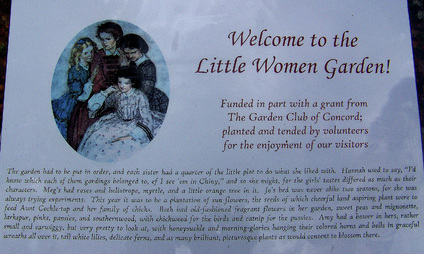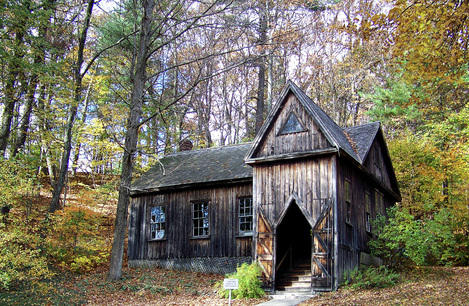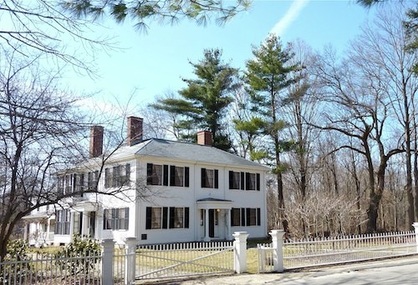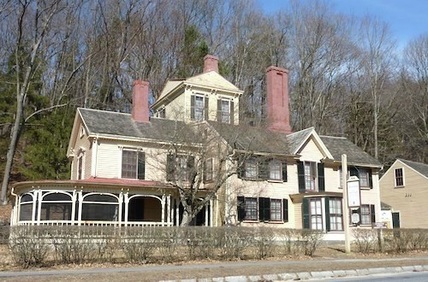Orchard House
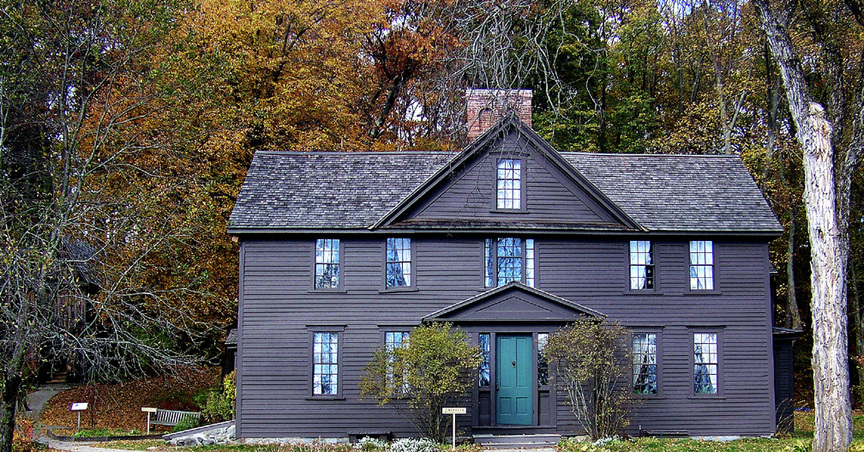
Orchard House From Wikipedia, the free encyclopedia
Built/Founded: Sometime between 1700 & 1710
2] Governing body: Louisa May Alcott Memorial Association Added to NRHP: October 15, 1966 Designated NHL: December 29, 1962 NRHP Reference#: 66000781 [1] Orchard House is a historic house museum in Concord, Massachusetts. It was the longtime home of Amos Bronson Alcott and family, including his daughter Louisa May Alcott who wrote and set her beloved novel Little Women there.
History The Alcotts had first moved to Concord in 1840, although they left in 1843 to start Fruitlands,[3] a utopian agrarian commune in nearby Harvard. The family returned in 1845 and purchased a house named "Hillside",[4] but left again in 1852, selling to Nathaniel Hawthorne who renamed it The Wayside.
The Alcotts returned to Concord once again in 1857 and bought another property in May 1858.[3] At the time of purchase the site included two early eighteenth century houses on a 12 acre (49,000m2) apple orchard.[2] Consequently the Alcotts named it Orchard House.[2] Bronson moved the smaller house to adjoin the rear of the main house, making a single larger structure.[2] While the home was being renovated, the family rented rooms next door at The Wayside while the Hawthornes were still in England.[5]
The Orchard House is on the historical road to Lexington, is adjacent to The Wayside, and less than half a mile from Bush the home of Ralph Waldo Emerson,[6] where Henry David Thoreau and the Alcotts were frequent visitors.
[edit] The Alcotts in residence The Orchard House was the Alcott family's most permanent home, with the family living there from 1858 to 1877.[2] During this period the Alcott family included Bronson, his wife Abigail May, and their daughters Anna, Louisa, and May.[2] Elizabeth, the model for Beth March, had died in March 1858 just weeks before the family moved in.[2]
Orchard House, 1941 The Alcotts were vegetarians and harvested fruits and vegetables from the gardens and orchard on the property.[7] Conversations about abolitionism, women's suffrage and social reform were often held around the dining room table.[7] The family performed theatricals using the dining room as their stage while guests watched from the adjoining parlor.[7]
The parlor was a formal room with arched niches built by Bronson to display busts of his favorite philosophers, Socrates and Plato.[8] On May 23, 1860, Anna married to John Bridge Pratt in this room.[8]
May, the youngest, was a talented artist.[9] Her bedroom contains sketches of angelic, mythological and biblical figures on the woodwork and doors.[10] In Louisa's room May painted a panel of calla lilies as well as an owl on the fireplace.[11] Copies of Turner seascapes by May hung in her parent's bedroom.[12]
In 1868, Louisa May wrote her classic novel Little Women in her room on a special folding "shelf" desk built by her father.[2] Set within the house[2] its characters are based on members of her family, with the plot loosely based on the family's earlier years, and events that transpired at The Wayside. Also written in the house were Bronson's Ralph Waldo Emerson (1865; published 1882), Tablets (1868), Concord Days (1872), and Table Talk (1877).[3]
On the grounds, to the west of the house, is a structure designed and built by Bronson originally known as "The Hillside Chapel", and later as "The Concord School of Philosophy". Operating from 1879 to 1888 the school was one of the first, and one of the most successful, adult education centers in the country.
[edit] The Orchard House today Orchard House is open for public tours daily, except for major holidays and between January 1 and 15.[13] An admission fee is charged.[13]
The exterior looks much as it did in the Alcotts' day. Care has been taken to keep extensive structural preservation work invisible.[14] All of the furnishings are original to the mid-nineteenth century, about 75% belonged to the family, and the rooms look very much as they did when the Alcotts were in residence.[2]
The Hillside Chapel The dining room contains family china, portraits of the family members, and paintings by May along with period furnishings.[7] The parlor is decorated with period wallpaper and a patterned reproduction carpet while family portraits and watercolors by May adorn the walls.[8] Abigail May's bread board, mortar and pestle, tin spice chest and wooden bowls are displayed on the hutch table in the kitchen.[15] Other original kitchen features include a laundry drying rack designed by Bronson, and a soapstone sink bought by Louisa.[15] The study is furnished with Bronson's library table, chair and desk.[16] The parent's bedroom contains many of Abigail May's possessions, including photographs, furniture, and hand made quilts.
Built/Founded: Sometime between 1700 & 1710
2] Governing body: Louisa May Alcott Memorial Association Added to NRHP: October 15, 1966 Designated NHL: December 29, 1962 NRHP Reference#: 66000781 [1] Orchard House is a historic house museum in Concord, Massachusetts. It was the longtime home of Amos Bronson Alcott and family, including his daughter Louisa May Alcott who wrote and set her beloved novel Little Women there.
History The Alcotts had first moved to Concord in 1840, although they left in 1843 to start Fruitlands,[3] a utopian agrarian commune in nearby Harvard. The family returned in 1845 and purchased a house named "Hillside",[4] but left again in 1852, selling to Nathaniel Hawthorne who renamed it The Wayside.
The Alcotts returned to Concord once again in 1857 and bought another property in May 1858.[3] At the time of purchase the site included two early eighteenth century houses on a 12 acre (49,000m2) apple orchard.[2] Consequently the Alcotts named it Orchard House.[2] Bronson moved the smaller house to adjoin the rear of the main house, making a single larger structure.[2] While the home was being renovated, the family rented rooms next door at The Wayside while the Hawthornes were still in England.[5]
The Orchard House is on the historical road to Lexington, is adjacent to The Wayside, and less than half a mile from Bush the home of Ralph Waldo Emerson,[6] where Henry David Thoreau and the Alcotts were frequent visitors.
[edit] The Alcotts in residence The Orchard House was the Alcott family's most permanent home, with the family living there from 1858 to 1877.[2] During this period the Alcott family included Bronson, his wife Abigail May, and their daughters Anna, Louisa, and May.[2] Elizabeth, the model for Beth March, had died in March 1858 just weeks before the family moved in.[2]
Orchard House, 1941 The Alcotts were vegetarians and harvested fruits and vegetables from the gardens and orchard on the property.[7] Conversations about abolitionism, women's suffrage and social reform were often held around the dining room table.[7] The family performed theatricals using the dining room as their stage while guests watched from the adjoining parlor.[7]
The parlor was a formal room with arched niches built by Bronson to display busts of his favorite philosophers, Socrates and Plato.[8] On May 23, 1860, Anna married to John Bridge Pratt in this room.[8]
May, the youngest, was a talented artist.[9] Her bedroom contains sketches of angelic, mythological and biblical figures on the woodwork and doors.[10] In Louisa's room May painted a panel of calla lilies as well as an owl on the fireplace.[11] Copies of Turner seascapes by May hung in her parent's bedroom.[12]
In 1868, Louisa May wrote her classic novel Little Women in her room on a special folding "shelf" desk built by her father.[2] Set within the house[2] its characters are based on members of her family, with the plot loosely based on the family's earlier years, and events that transpired at The Wayside. Also written in the house were Bronson's Ralph Waldo Emerson (1865; published 1882), Tablets (1868), Concord Days (1872), and Table Talk (1877).[3]
On the grounds, to the west of the house, is a structure designed and built by Bronson originally known as "The Hillside Chapel", and later as "The Concord School of Philosophy". Operating from 1879 to 1888 the school was one of the first, and one of the most successful, adult education centers in the country.
[edit] The Orchard House today Orchard House is open for public tours daily, except for major holidays and between January 1 and 15.[13] An admission fee is charged.[13]
The exterior looks much as it did in the Alcotts' day. Care has been taken to keep extensive structural preservation work invisible.[14] All of the furnishings are original to the mid-nineteenth century, about 75% belonged to the family, and the rooms look very much as they did when the Alcotts were in residence.[2]
The Hillside Chapel The dining room contains family china, portraits of the family members, and paintings by May along with period furnishings.[7] The parlor is decorated with period wallpaper and a patterned reproduction carpet while family portraits and watercolors by May adorn the walls.[8] Abigail May's bread board, mortar and pestle, tin spice chest and wooden bowls are displayed on the hutch table in the kitchen.[15] Other original kitchen features include a laundry drying rack designed by Bronson, and a soapstone sink bought by Louisa.[15] The study is furnished with Bronson's library table, chair and desk.[16] The parent's bedroom contains many of Abigail May's possessions, including photographs, furniture, and hand made quilts.
|
Emerson House
If you're an Emerson fan, you'll find his house fascinating because it still contains many of the original furnishings (except for Emerson's study, now on display at the Concord Museum across the street). The house continues to be owned by Emerson's descendents, who maintain it as a private museum and offer guided tours to visitors.
Originally built as a summer place in 1829, the house became the year-round home of the Emerson family when they bought it in 1835. Thoreau, the Alcotts, Margaret Fuller, and many other friends all visited the Emersons here throughout the years. Emerson's home in Concord, Massachusetts Although an 1872 fire almost destroyed the house, Emerson, his family, and his papers all escaped harm. Neighbors surprised Emerson by taking up a collection and repairing the house while he traveled abroad. Today, the house feels so unchanged that you can almost imagine that you'll find Emerson hard at work in his study. The Wayside
Just up the road from Orchard House is The Wayside, where the Alcott family lived for 7 years before moving to Orchard House. After the Alcotts moved, Nathaniel Hawthorne bought the house and gave it its present name.
In the 1880s, Boston publisher Daniel Lothrop and his wife Harriett, who wrote Five Little Peppers under the pen name Margaret Sidney, lived at The Wayside. Fans of Hawthorne's writing, they made as few changes as possible to it and even acquired some of Hawthorne's furniture for it. The Wayside, Concord home of 3 literary families The Wayside, part of the Minute Man National Historical Park since 1965, probably dates from the late 1680s, although additions and the Victorian-style porch have been added onto the original Colonial structure. |
Concord Authors and their homes
Walden Pond
Although technically located within the town of Lincoln, Walden Pond lies only about 3 miles to the south of Concord. When Henry David Thoreau built his famous cabin in the woods near the pond in 1845, his friend and mentor Ralph Waldo Emerson owned the land and let him build his cabin and live rent-free in exchange for clearing some land and doing a few other chores.
Walden Pond and surrounding woods where Thoreau built his cabin Walden Pond continues to be even more popular today than during Thoreau's time. During the summer, many people come to swim, walk, and enjoy the same vistas that inspired Thoreau. The pond itself is what's called a glacial kettle pond. It's deep - over 100 feet - and surrounded by Walden Woods, totaling 2,680 acres. During summer months, Park Rangers conduct tours of the area. Stop by the Visitors Center next to the parking lot to get times and details. |
